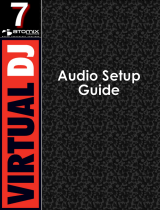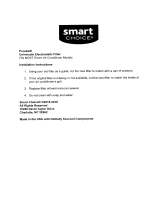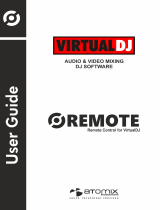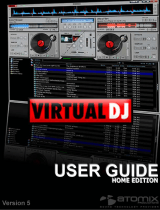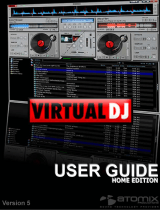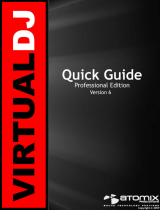Page is loading ...

1

2
PLATFORM INTRODUCTIONS
HOME, BROADCASTER, PRO BASIC, and PRO FULL
3
3
INTERFACES – ZONES
BROWSER
FILE SYSTEM / FOLDER STRUCTURE
FILE / SEARCH RESULTS
4
4
5
7
AUDIO AND VIDEO TAG SUPPORT
9
GLOBAL SEARCH
13
SEARCHING
14
NETSEARCH
16
TRACK OPTIONS
16
BPM ANALYSIS AND KEY DETECTION
17
COMPUTER BEAT GRID (CBG) AND MANUAL BPM CORRECTION
17
PLAYLIST AND AUTOMIX
19
EDITING AUTOMIX MIX POINTS
22
SIDELIST
23
FILE SYSTEM / FOLDER STRUCTURE ORGANIZATION
FAVORITE FOLDERS
VIRTUAL FOLDERS
FILTER FOLDERS
24
24
24
25
NESTING FOLDERS WITH VIRTUAL FOLDERS
26
DECK CONTROLS
28
MULTI-DECK CONTROLS
31
INTERNAL MIXER CONTROLS
33
MULTI-DECK INTERNAL MIXER CONTROLS
34
TOOLBAR CONTROLS
35
RHYTHM WINDOW
36
CONFIGURATION SETTINGS
SOUND SETUP
OPTIONS
PERFORMANCES
MAPPERS
SKINS
INTERNET
CODECS
VIDEO
INFO
37
37
38
41
43
47
48
49
50
51
SAMPLER
52
EFFECTS (AUDIO)
54
VIDEO (FEATURES,TRANSITIONS, EFFECTS)
55
KARAOKE and ROTATION LIST MANAGER – pc version only
57
RECORDING AND BROADCASTING
59
LEGAL INFORMATION (End User License Agreement EULA)
63
TABLE OF CONTENTS

3
VirtualDJ offers a few different platforms of choice to fit a DJ‘s needs. Let us take a look at
each platform and what each provides in functionality.
HOME (FREE)
Provides all the enjoyments of PRO without all the
overhead of complex sound configurations, complex
controller setups, broadcasting, or full video output.
VirtualDJ HOME is built for the simple at home setup
where a DJ can explore the art of mixing by simply
using the keyboard, mouse, and built-in sound card.
BROADCASTER
Take your mixing to the next level and bigger
audience with BROADCASTER, where you can
stream your mix straight to your friends or even a
bigger audience using a web radio server connection.
BROADCASTER can help get your DJing skills and
talent known.
PRO BASIC
An excellent starting platform where the DJ needs to
use sound configuration that requires more flexibility
to connect to an external mixer, but does not require
capabilities like timecode setups, controllers, or full
video output. PRO BASIC is most commonly used by
house party and mobile DJs that just want the basics.
PRO FULL
The flagship product – full featured capabilities to
accommodate almost any DJ‘s needs or desires.
Featuring Timecode (Digital Vinyl System) setup,
external controller device (HID/MIDI/Firewire/Serial)
setup, Full Screen Video output, broadcasting, and
much much more …
Which every your choice of platform, VirtualDJ offers a wide range of features that brings more
creativity to your mixes, providing features that will improve your skills, and take your DJ
experience to a whole new level.
INTRODUCTION
PLATFORM INTRODUCTIONS

4
Before beginning to use VirtualDJ, it is important to familiarize yourself with the controls and ―zones‖ of
the software. Upon opening VirtualDJ for the first time, your screen resolution is evaluated and one of
the included multiple resolution skins are selected and displayed for you automatically. To change to a
different skin, click on the ―Config‖ menu then select the ―Skins‖ tab to access the available selections.
VirtualDJ Pro: Widescreen (1280x800)
1. BROWSER I SAMPLER / EFFECTS I RECORD
Browse your music folders, preview tracks; Create, edit and save your playlists;
Adjust effects - video and audio, Record and save mixes, Internet Broadcasting setup
2. DECK 1 CONTROLS
Drag and drop music from the browser to this virtual deck.
Track title, beats per minute display, counters, Transport Control
3. DECK 2 CONTROLS
Drag and drop music from the browser to this virtual deck.
Track title, beats per minute display, counters, Transport Control
4. CENTER PANEL
Multiple panels can provide access to Crossfader, Gain, Volume PFL Controls,
Video controls, Video preview windows, Effect controls, Timecode Scratch Interface
5. RHYTHM WINDOW
This window tracks the waveform of each song loaded or playing on a deck. This area also
features a Computer Beat Grid (CBG) used for visual mixing and beat-matching.
VirtualDJ can also be used in a multiple deck configuration. You can find more information about how
VirtualDJ‘s Multi-Deck setup functions in the Multi-Deck section.
INTERFACE - ZONES

5
The Browser Zone area is where you navigate and organize files stored on a local, external, or network
hard disk.
The Browser zone is divided into panels.
1. File System / Folder Structure
2. File / Search Results
3. Automix Playlist
4. Sidelist
Panel 1: File System / Folder Structure Panel
VirtualDJ provides several organizational groupings of your collection and access to a few third-party
interfaces by default. You can also create additional navigation aids like Virtual Folders, Filter (smart)
Folders and Favorite Folders. To better understand these options, click the ―Config‖ button and view the
―Browser‖ tab.
The ―Browser‖ tab allows you to select which groupings or interfaces will be viewed. Each item
‗checked‘ will have an associate entry on the File System / Folder Structure panel.
Volumes – shows the File System navigation option to access all hard drives connected
Desktop – shows the File System navigation option from the Desktop level
NetSearch – show the files cached from NetSearch, and provides access to the search engine for our
Premium Membership audio search and publicly available search to find those last minute requests.
You can then instantly stream search result directly from the Internet source.
** To learn more about this feature and additional features that compliment the NetSearch
capabilities, visit our website at www.virtualdj.com.
GeniusDJ – shows recommendations from your own library based on what you are currently playing.
Genres – provides a generated tree of Genre types based on the imported ID3 tag Genre field. By
selecting on the various listed genres the file browser panel (2) only shows those entries that match the
tag.
BROWSER

6
History – provides access to data stored about each session use of VirtualDJ. The data is stored as
.m3u playlist files and it is stored in the My Documents -> VirtualDJ\Tracklisting folder.
History data is saved on the fly in order to provide running history of played tracks for each 24hr
timeframe of use.
iTunes – displays iTunes playlists and uses the information in the playlist for accessing files. If the files
don‘t exist per the playlists path, an ‗Error‘ shows up in the deck‘s display when attempting to load the
track.
Crates – allows access to the crates structure created and utilized by the Serato™ Scratch Live
Playlists – show or hide the contents of the My Documents -> VirtualDJ\Playlist folder. This is where
an Automix playlist is saved by default. Playlists in VirtualDJ are saved in Unicode format using the
.m3u extension.
Favorites – show or hide any created folder favorites, created from a right-click on a folder in the
Desktop navigation structure and selecting ―Set as favorite‖ from the menu or by using the icon on
the panel‘s right divider bar.
VirtualFolders – show or hide any created VirtualFolders created from clicking on the icon found
on the right divider bar
FilterFolders – show or hide any created FilterFolders created from clicking on the icon found on
the right divider bar
BROWSER

7
Panel 2: File / Search Results
VirtualDJ provides several elements of information about each track. The information is a combination
of VirtualDJ defined data fields and supported file tag data. By default the title of the song and artist are
listed for each file along with columns for beats per minute (BPM) and duration (Length) with additional
columns, explained further in the manual. The width size for each column can be modified individually
and by clicking on a column title the contents are sorted. For example, clicking on the artist column
sorts the browser by artist initially in ascending order. Click again for descending. To set all columns to
the same width you can double-click on any column title.
The tracks title and artist are automatically filled in, if the file is named according to two standard
conventions, i.e. (artist) title.ext OR artist - title.ext OR the ―Tags‖ option is set to ―Enabled‖ in the
―Config‖, ―Browser‖ tab, Infos Gathering section.
When a track is loaded to either deck for the first time, VirtualDJ will analyze and calculate the track for
BPM, Key, Length, Gain and Bitrate. It is recommended that you analyze all tracks in your collection
prior to first use. Analyzing multiple tracks before use is covered later in this guide. All track
information is then stored inside individual drive database files. And all data is stored and saved at time
of discovery or data entry immediately to the database(s).
VirtualDJ uses several different graphics to represent the type or status of a track. The following icon
key show the standard icons used on VirtualDJ developed skins.
Track is unknown and was never played or scanned by VirtualDJ.
Track is known and has been scanned by VirtualDJ.
Track has already been played during this session.
Audio file with a linked video.
Video file
Karaoke file
Track has a BPM difference greater than +/- 20% pitch of current playing track
NetSearch audio result and is validated quality file from our Premium Membership service
NetSearch audio result and not validated as quality file from our Premium Membership service
NetSeach video result and not validated as a quality file from our Premium Membership service
** Note: The icons are customizable and if using a user designed custom skin the icons may not be the same as listed above.
BROWSER

8
The browser area is determined by the skin designer on how much space it will use as part of the skin.
However, you can use the Browser Zoom button to maximize the browser area to consume the entire
skin area.
The Browser Zoom button is the dual monitor graphic found to the far right of the Search box.
Click on the graphic and the browser area will expand to consume the entire skin. This is very usefully
when planning your events where you need to see all results of your search.
BROWSER

9
VirtualDJ supports ID3Tags of MP3 audio files and MP4 and MOV tags of video files. VirtualDJ has
always provided the fastest information access about one‘s collection by using VirtualDJ‘s database.
Adding direct tag access to every file considerably slows applications ability for timely browsing and
searching.
VirtualDJ retrieves and stores the tag information in similar fields as part of its own database. The tag
information stored can be updated at anytime using the VirtualDJ file menu. Since tag data is not
directly accessed, any of the information can be changed using the File Info dialog and it will not affect
the tag info of the file.
** VirtualDJ currently supports these types – ID3tags (MP3), MP4, MOV
Retrieving Tag Data
This can be accomplished in several methods at different points in time. The first and most common is
using the Config -> Browser tab‘s options in the Infos Gathering section.
TAGS
Enabled – Supported tag fields (BPM, Album, etc.) are read immediately when track first seen.
Disabled – Tags are not read and need to be added manually through the browser interface.
ARTIST/TITLE
Enabled – If the corresponding tags do not contain data for the Title and Artist fields then the
filename is parsed and used for those fields. Parsing format of the filename is Artist – Title.
Disabled – Do not read the tags and use the file name parsing.
COMMENTS
Enabled – Load the tag Comment field when track first seen.
Disabled – Do not load the tag comment field
COVERS
Local Search Only – for the CoverFlow viewer files already locally stored will be used (to include
ID3tag embedded)
Download Exact Match – if no cover found locally, download a cover that only matches based on
the song‘s information
Download No Matter What – if no cover found locally, download anything that closely matches
using the song‘s information
Don‟t Search – don‘t ever look for covers if no cover exists
Tag information can also be retrieved by using a right-click on a specific track in the browser and
selecting File Info.
AUDIO AND VIDEO TAG SUPPORT

10
Under each field with the up-arrow button can be read from the tag and import the information into
VirtualDJ‘s database. Click on the button to copy the data into the VirtualDJ data field. Using the
right-arrow button found under a field is used to write the VirtualDJ data field information into the files
tag. VirtualDJ supports writing to MP3 and MP4 tag formats.
The right-arrow button next to the Filename field is used to parse the file name into the Artist and
Title fields. Click on the up-arrow will rename the file using the Artist and Title fields and rename the file
in the format of {artist} - {title}.
From the File Info dialog you can navigate freely through the tracks that are displayed in the browser
area when you opened the File Info dialog. Use the [Prev] and [Next] buttons in the bottom left.
When opening the File Info as part of a highlighting multiple files, the [Apply to all] button can be used
to apply changes to the selected songs. The fields that changes can be applied to in this situation are
Artist, Album, Composer, Genre, Comment, Field1, Field2, and Rating.
Another method of retrieving tag info is through the browser directly with multiple files selected. Right-
click on a group of selected tracks and then choose from the Batch option the following:
Title from tag
Title from filename
Reload tag
Erase comment
Download cover
AUDIO AND VIDEO TAG SUPPORT

11
Displaying VirtualDJ data field columns
In the file browser or playlist panels, right click on any column title and the list of available fields is
displayed. Select a field title to place a check next to the name to have it included in the display.
Select the field name for a checked item to have it removed from the browser display.
To change the order of the columns select the Order… option from the bottom of the list. The same list
is then presented in a new dialog where you can select and move the
fields using up and down arrows in the upper right of the dialog box.
AUDIO AND VIDEO TAG SUPPORT

12
Data Fields
Loaded On – shows the deck that the track is currently loaded on
Title – Title of the track
Artist – Artist of the track
BPM – Beats per Minute as analyzed by VirtualDJ
Length – Length of the track in Minutes:Seconds
Album – Album the track is associated with
Genre – Genre of the track
Key – Key of the track as analyzed by VirtualDJ
Bitrate – the bitrate of the encoded audio file
Year – Year in which the track was produced
Comment – comments about the track
Play Count – stores the running play count of the track
First Seen – stores the date of when the track was first added to the database
First Play – stores the date of when track was first ever played.
Last Play – stores the date of when track was last played
Drive – drive where the track is located
Filepath – absolute file path location of where the track is stored
Filename – file name of the track as reported by the operating system
Filetype – file type based on the file‘s extension
Filesize – file size as reported by the operating system
Filedate – modified date of the track as reported by the operating system
** Filedate is read in real-time and not stored in the VirtualDJ database
LinkedVideo – shows the filename of the video file linked to the track
Key (Number) – stores the analyzed key value of a song in numeric notation
Composer – Composer information for the track.
BPM Diff – dynamically displays the BPM difference compared to the currently playing track.
Key Diff – dynamically displays the Key difference compared to the currently playing track.
Rating – popularity rating field on a 5 point system
Field1 / Field2 – free form text fields to be used for custom information
Key Visual Indicators displayed in the Browser
Asterisk ( * ) in BPM column – identifies tracks that have a pronounced beats per minute (BPM)
rhythm for use with Beatlock and Tempo Automix features
Exclamation ( ! ) in Time column – indicates that the file is corrupted (probably following a bad copy)
and that it may finish abruptly or there may be excessive noise in the track
AUDIO AND VIDEO TAG SUPPORT

13
The database management system comes with additional tools found on the Config -> Browser tab.
Save ‗On the Fly‘ during each session use
Automatic check of database integrity at start
Manually check the database integrity
Fix database error(s)
Clean out database entries for missing/moved files
VirtualDJ updates and saves the database immediately when changes are made. At start of the
application the integrity of the database file(s) are validated. If a problem is detected a message box
will be displayed identifying which database has the problem with a recommendation of how to fix the
problem.
Usually the database only needs a Fix - here are the steps:
1. Open the configuration dialog
2. Go to the Browser tab
3. Select the Drive from the drop-down
4. Click the ‗FIX‘ button
Other options for managing the database(s) are -
CHECK – this runs a validation of the database to ensure that all database file references are still valid
and existing stored files on that drive. The process simply re-labels the FilePath entry for the file if it can
not be found. Data about that file is not lost.
CLEAN – this process will REMOVE any database information about files that are no longer valid. This
is necessary for cleaning up the Global Search capabilities.
DATABASE MANAGEMENT

14
VirtualDJ provides an intuitive on the fly search capability. Adding files to the global search is quite
easy and can be done in two ways.
First is by setting the ‗Search Database‘ property in the Configuration‘s Browser tab to ‗Add
automatically‘. This will add any files not already part of the
search (new additions) when browsing the folder structure of
your collection.
The other option is ‗Add manually‘, requires using the ‗Add to
Search DB‘ option to be selected on the actual entry in the main
browser interface and then right-clicking and selecting ‗Add to
Search DB‘.
In either scenario, once added to the Global Search; the ability
to find the file is always available when doing a search. The
difference is in the results display of the search determines if it is in the currently selected folder or
elsewhere in the system.
The search field is located at the top of the browser panel. To search the files listed in the database, left
click on the search field then type your search text.
Searching is instant and not necessary to type the text in its entirety, a few letters are enough to
produce results where you will see the single title of what you are looking for.
If you want to limit the search results to specific types of file, click on the eye
graphic at the right of the search box and chose from the Show Music, Show
Videos, and Show Karaoke options.
If your search does not produce any results you can ‗save‘ the search
criteria to a special text file. Click on the yellow note graphic. This allows for
a list to be created that can be used as a ‗need to buy‘ list for improving your collection. This file is
called ―SearchLog.txt‖ and can be found in your My Documents -> VirtualDJ folder.
When putting together your search you can use a couple ‗wildcard‘ characters when you are unsure
what the proper spelling might be. The wildcard characters are the question mark ‗?‘ and an asterisk
‗*‘. The question mark ‗?‘ indicates that any character can fill/use that 1 character space. The asterisk
‗*‘ means to allow any set of characters to fill/use the space in between the characters on either side of
it.
For example – using ‗sh??t‘ will produce results consisting of tracks like ‗Push it‟ by Salt-n-Pepa,
‗Shout‘ by Otis Day and the Knights, or tracks by the artist ‗Ashanti‘. In all these cases there is a 5
character match with the search term where the first 2 characters are ‗sh‘ and the last character is a ‗t‘
with no more than any two (2) characters in between.
If the search term is changed to ‗sh*t‘ then the result will be a larger selection of tracks from words as
short as ‗shot‘ or ‗shut‘ to ‗She Blinded Me With Science‘ by Thomas Dolby.
GLOBAL SEARCH
SEARCHING

15
UNDERSTANDING THE RESULTS
Once you have entered the search term, VirtualDJ‘s center browser section displays the results that
match your search string.
In the following example, a search on ‗Bobby Valen‘ is entered. The 2 file(s) listed above the dividing
line represent the file(s) found in the folder that is currently highlighted in the left folder browser panel.
All other files below the dividing line are files that exist elsewhere in your collection.
What can be searched?
Just to the right of the search box there is the ―search fields‖ selection button. Click on the magnify
glass and a list of searchable fields is presented.
Depending on what fields are selected the search results will very. To ensure maximum results for all
searches, select all the field choices. However, this may produce more than what you want.
To view your entire collection, just enter an asterisk ( * ) as the
search string and now the entire database is displayed.
To search for items within a specific BPM range, enter a
beginning and ending range (110-120). With the BPM column
selected, the displayed results are tracks in the range of 110.0
to 120.1 BPM. The additional .1 on the second condition
ensures that all tracks that are ###.0 are shown as well.
When ―Key‖ is selected as a searchable field, both the Key
and Key (Number) fields are searched.

16
With the NetSearch options selected, VirtualDJ will also search the NetSearch services for results
matching the search criteria. VirtualDJ will only produce results where the Artist and/or Title of the track
match the search criteria.
NetSearch can be used by either selecting the NetSearch option from the left navigation panel or by
having the NetSearch options activated in for the entire database.
You can also set when VirtualDJ should produce results from NetSearch. With the ―Only NetSearch
when no local results‖ is selected, then VirtualDJ return results from the search service when no results
are found within your collection. Otherwise, if not selected and NetSearch options are active then the
NetSearch results will be at the end of the results listed.
Search results are displayed in the following order:
Local Selected folder results
Entire collection results
NetSearch results.
Each separated by a dividing line as mentioned on the previous page.
If the NetSearch option in the left panel is selected, then ONLY NetSearch results are always
displayed.
„Search in Folder‟ and „Search in Drive‟
If both options are selected, then results display shows the separation line between folder results and
drive results.
With "Search in Folder" selected, but not "Search in Drive"; it shows only the files from the current
folder.
If ―Search in Drive" selected, but not "Search in Folder"; there is no distinction (separation line) between
the files that are in currently browsed folder or from some other location. The result always displays the
tracks from the entire search database.
Right clicking on a track displays many options:
Preview – for launching the separate track preview interface
File Info – for launching the File Info dialog to modify data field content
File Operations like - copy, move, and delete files
o When selecting Delete a warning is displayed about
deleting the file(s) from your system
BPM analyze track options – Re-Analyze or Manual Edit
Add OR Remove songs from the search database
Remove the link to a video file for audio track
TRACK OPTIONS
NETSEARCH

17
The BPM Engine analyzes the audio to determine the tempo of the track. Analyzing a track can be
performed 2 ways – Load the track to a deck or right-click on the track in the Brower panel and select
BPM -> Re-Analyze. You can also analyze a group of tracks contained in a folder from the left
Navigation panel, right-click on the folder and select Scan for BPMs.
If the tracks have been analyzed by an external application prior to being loaded into VirtualDJ and that
value is stored in the BPM tag, the BPM Engine will use the stored value as a reference when
analyzing the track. VirtualDJ will calculate a more precise value to a 0.05 BPM precision not more than
+/- 1 beat per minute away from the value of the tag.
Part of the BPM Engine is also a Key Detection Engine. Determining the ‗musical key‘ of a track
provides the ability to harmonically mix tracks. The Key Detection Engine strongly favors minor keys,
as most studio production songs are in minor key. But if the key is strongly major, it will be reported as
a major key.
If you wish to manually ‗tap-out‘ the beats per minute of a song, you can left-click to the beat on the
BPM button of the appropriate deck playing your track. If you would like to assign a keyboard shortcut
or assign a button on a controller, the mapping action beat_tap action can be assigned.
Last, if the BPM (or the Key) is manually entered using the File Info dialog, then VirtualDJ will use the
entered value and will not analyze the BPM or Key. If forced by selecting the BPM -> Re-Analyze
function the track is re-analyzed without regard to existing data or how the data was entered.
Part of VirtualDJ‘s BPM Engine is to calculate the Computer Beat Grid (CBG) of the track. The
computer beat grid is a 4/4 beat measure indicator for identifying the timing gap of the track. This
becomes helpful when manually beat mixing a track or using VirtualDJ‘s synchronized play (SYNC),
Beat Lock, or Automix Tempo Mix features.
In rare cases, when the BPM and the CBG is not correctly calculated, you can easily correct manually
by right-clicking on the appropriate deck‘s BPM button for the track.
With the ‗Adjust BPM Values‘ dialog you are provided several options to make the adjustments.
EDIT BPM tab
BPM – manually move the value up or down in .1 increments
with the arrow buttons. Or, quickly half or double the shown
value with the /2 and x2 buttons.
Phase – used to adjust the CBG markers. The left and right
arrows makes very fine adjustments, where the ¼ +/- buttons
provide ¼ beat adjustments.
Re-Analyze – forces the re-analysis of the track disregarding any
manual adjustments or settings.
Copy from other deck – copy the BPM of the track on the
opposing deck to be use for the track being modified.
BPM ANALYSIS AND KEY DETECTION
COMPUTER BEAT GRID (CBG) AND MANUAL BPM CORRECTION

18
EDIT GRID tab
Alternatively, an anchor method can be used. First tap-out the beat using the "Manual Beat Tap" button
while the track playing.
Second, pause the track and move the track to the first downbeat (first beat), and click on "First
anchor". Then advance to the upbeat (second beat), and click
on "Second anchor". Check that the number of beats displayed
corresponds well to the number of beats between the two
anchors.
Then go further in the music, and repeat the "second anchor"
operation. If you notice that the beats and the CBG shift then
repeat the placing of the second anchor a couple more times.
Normally two or three anchors should be enough to obtain an
accurate CBG.
** For more information on how the CBG is used for beat matching, sync, and Automix Tempo mixing,
see the section about the Rhythm Window later in the manual.
COMPUTER BEAT GRID (CBG) AND MANUAL BPM CORRECTION

19
The Automix feature works from a single deck. By default it is Deck 1; however, prior to starting the
Automix if Deck 2 is selected as the active deck then Deck 2 is used. By utilizing 1 deck this frees the
opposite deck for staging the first song to be used once you decide to stop the Automix process.
In addition to drag and drop, playlists can be created. Playlists are groups of tracks prearranged in a
desired order of play. To Access the playlist, move your mouse or drag songs over the ―Playlist‖ panel
(3) on the right side of the browser. The window automatically expands to show the working area and
current list if populated.
Playlist Controls
Activate / Deactivate the Automix mode
Access the Playlist management menu
Using the pad-lock icon at the bottom of the browser section, you can lock the Playlist panel to a set
width and block the auto-shut of the panel.
*You can also lock it and reduce its size to zero if you do not wish for it open automatically or be seen.
Playlist Setup
Tracks to be auto-mixed can be placed into the Playlist panel from the File Browser panel (2) by using a
drag and drop method. Also, predefined playlists can be used and auto loaded.
In the Config -> Options tab there is an option for ―AutoLoad Playlists‖.
The available values have the following functionality:
Disabled – a contents of the play list are
displayed in the center File Browser panel only
Always – when a play list is selected in the browser the contents are immediately loaded to the
playlist
Smart – doesn't change the playlist when you click on a playlist folder, if the actual playlist has
been manually edited
PLAYLIST & AUTOMIX

20
Playlist & Automix Management
Using the Playlist management menu by clicking on the [+] icon and choose from the available options
for how the automix will function and tracks are managed in the playlist.
Automix Types – 5 modes
SMART – VirtualDJ attempts to determine
the optimal mix point based on the outro of
the current track and intro of the upcoming
track – mix time varies from ~4 to ~8 secs
depending on the tracks
FADE (remove intro/outro) – attempts to
remove the dead air intro or outro segments
and creates a crossfade point based on the
settings of the Automix Length
FADE (remove silence) – keeps the entire
track from beginning to end while removing any ‗dead air‘ or ‗silence‘ that may be present in the
track and creates a crossfade point based on the settings of the Automix Length
FADE (remove nothing) – keeps the entire track from beginning to end and creates a
crossfade point based on the settings of the Automix Length
NONE (back-to-back) – this is a simple CUT mix that plays the files from complete from start to
finish including any air gaps at the beginning or end
Automix Length
Length used for the Automix FADE types. Lengths are 0 seconds (CUT), or
1, 2, 4, 8, or 16 seconds fades using the FULL crossfade.
Repeat
Two different ‗Repeat‘ options are available. When clicking on the options
button (‗+‘) the ‗Repeat‘ option lets you repeat the whole Automix Playlist.
Once all tracks have been played, the Automix will start over again with the
first track in the list. Prior to or during the Automix, right click on a song and select ‗Repeat‘ to have that
song continuously repeat until the ‗Repeat‘ is deselected.
Auto remove played – removed the played track from the playlist after the transition to the next track
Clear – clears the entire playlist of all tracks
Shuffle – shuffles the contents of the playlist for play
Remove played – removes any already played tracks from the playlist
Remove duplicates – a removes any possible duplicates from the playlist
Save – provides function to save the playlist for future use. Saved playlists can be loaded from the
Playlist option found on the left Navigation panel. Saved playlists are stored to the My
Documents/VirtualDJ/Playlists folder
PLAYLIST & AUTOMIX
/
